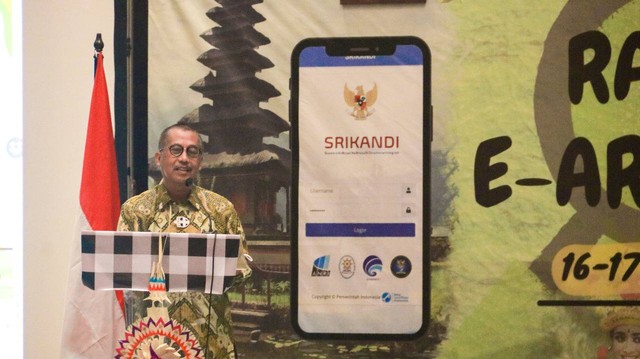Tentang KamiPedoman Media SiberKetentuan & Kebijakan PrivasiPanduan KomunitasPeringkat PenulisCara Menulis di kumparanInformasi Kerja SamaBantuanIklanKarir
2025 © PT Dynamo Media Network
Version 1.101.0
Konten dari Pengguna
A Solution to the Environmental Paradox in Archival Digitalization
13 Maret 2024 11:18 WIB
·
waktu baca 6 menitTulisan dari Leonardo tidak mewakili pandangan dari redaksi kumparan

ADVERTISEMENT
In October 2020, the National Archives of the Republic of Indonesia (ANRI) launched a digital platform called the Integrated Dynamic Archiving Information System (SRIKANDI). The platform aims to support the national archiving digitalization process targeted for completion in 2024. Therefore, the process has been carried out gradually in every government agency, from ministries/institutions, local governments, to academic institutions.
ADVERTISEMENT
In addition to the time efficiency aspect, the national archiving digitalization mission is also based on environmental reasons. In fact, this program is one of the government's concrete steps in achieving the Sustainable Development Goals (SDGs) 2030 and Net Zero Emission (NZE) 2060. This is because the digital archiving system is considered more environmentally friendly than analog archiving, which requires paper and large storage space. Therefore, this mission is expected to reduce greenhouse gas emissions and achieve carbon neutrality.
However, several recent studies have revealed the opposite (Dzwigol et al., 2021; Shvakov & Petrova, 2020). On one hand, digital transition and technology can be key factors in achieving these environmental goals. Conversely, the process of digitizing archives and their management is always haunted by the challenge of energy consumption efficiency. The digital ecosystem that encompasses various things, such as the internet and data security, requires a significant amount of energy consumption. The reason is, more than 50% of Indonesia's electricity needs (36.98 GW) are still generated by coal-fired power plants (PLTU) (Sansuadi & Nugroho, 2022).
ADVERTISEMENT
Therefore, every digital transition mission needs to pay attention to the potential paradox above. This is intended so that the management of digital archives in Indonesia does not produce counterproductive effects. So, how to ensure that archiving digitization and its management can bring benefits and not create threats to the environment?
Environmental Kuznets Curve
One theoretical model that describes the relationship between digitalization and its environmental impact is the Environmental Kuznets Curve (EKC). In EKC, the environmental impact is measured by the production of greenhouse gas emissions equivalent to carbon dioxide (CO2). The relationship is depicted in an inverted "U" shape. The curve shows that in the early stages of digital transition, CO2 emission production will increase. However, at a high level of digitalization, CO2 emissions will be lower. The turning point will be reached on average within one to four years after the digital transition process begins. However, the delay is often overlooked.
ADVERTISEMENT
One meta-analysis study that aligns with the EKC Model was conducted by Alatas (2021). The study analyzed data from 93 countries between 1995 and 2016 and found a positive impact of digitalization on carbon emission reduction. The single-door digital method makes energy consumption more efficient compared to the analog one. The entire process, from data creation to information dissemination, is carried out on a single platform. Therefore, digitization becomes a key aspect of the zero-carbon vision.
However, other multidisciplinary research shows that the EKC Model only applies under certain conditions (Kuzior et al., 2022; Lee & Brahmasrene, 2014). Therefore, this model cannot always be generalized to every context. In fact, the correlation coefficient between the level of digitization and CO2 emission reduction shows a low value. Additionally, no significant influence was found between the two variables.
ADVERTISEMENT
The academic findings above are also affirmed by empirical facts, especially in European Union countries. European Commission (2021) noted that of the three countries with the highest digitalization levels (Finland, Denmark, Sweden), only Sweden is among the three countries with the lowest greenhouse gas emission production levels (Malta, Sweden, Croatia). Although Finland and Denmark have consistently shown a reduction in greenhouse gas emissions over the past five years.
In addition to the European Union, China, as a country with a massive digitalization mission, is also facing a similar problem. Instead of reducing greenhouse gas emissions, the "Broadband China" program has made it the largest energy consumer in the world (Chen et al., 2019). This has also made China the country with the largest emitter of CO2 emissions in the world, even exceeding the total emissions of the United States and the European Union.
ADVERTISEMENT
Various facts above seem to form a paradox: digitalization can save, but also threaten the environment. The presence of digitalization does not automatically bring change. In fact, Sadorsky's research (2012) found that digital transition in developing countries cannot reduce greenhouse gas emissions. However, there is at least one temporary conclusion, that the role of archival digitalization in environmental sustainability needs to be supported by various other factors.
The Role of Renewable Energy
The results disparity in previous research is caused by one fundamental indicator. Research that affirms the EKC Model tends to be conducted in places with new and renewable energy (NRE) infrastructure. This infrastructure consists of non-fossil fuel power plants, NRE regulations, and green technology innovations.
ADVERTISEMENT
Conversely, research that negates the EKC Model is conducted in countries that still use fossil fuels and coal as their primary energy sources. This shows that the source of energy determines whether archival digitalization benefits or harms the environment. Therefore, as a developing country, the conclusion of Sadorsky's research (2012) can be a reflection for the archival digitalization process in Indonesia. Without clean energy, digitalization will only be a mere organizational slogan. Moreover, it tends to be a dangerous false solution (greenwashing).
The digital transition needs to be carried out simultaneously with the energy transition. However, as with any transition, these processes do not have to be carried out within a revolution framework. The hybrid method between NRE and conventional energy sources can be an option for the archiving digitalization process, especially on a local scale, such as government agencies and educational institutions.
ADVERTISEMENT
Among the various types of NRE, solar panels are one of the most efficient sources in implementing energy transition on a local scale. At least, the use of this type of NRE can reduce the annual conventional electricity requirement by up to 40%. In addition to its high utilization prevalence rate, solar panels are very diverse and can be customized to specific needs. Three 340 Watt-peak (Wp) solar panels can generate an average of 1 kilowatt (kW) of electricity (Gunoto & Hutapea, 2022). This amount of energy can operate a 200-Watt archival digitalization machine for five hours.
However, in various situations, this goal can turn into challenges or even threats. That is why the use of renewable energy can be a solution to the potential paradox in the archival digitalization process. The initial steps of digitalization has been carried out by ANRI through the release of the SRIKANDI platform need to be supplemented with a transition to renewable energy. One tangible form of this is by using solar panels as an alternative electricity source and a blend alongside conventional energy from PLTN in archival digitalization processes.
ADVERTISEMENT

